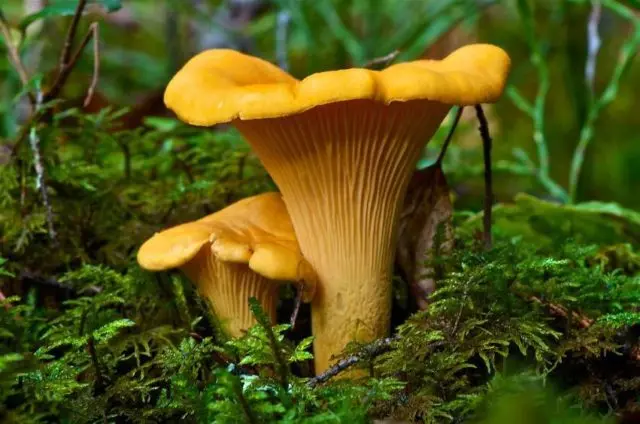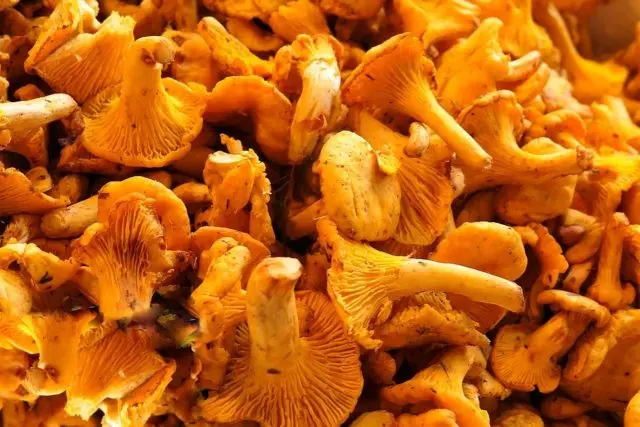Contents
You can get poisoned by chanterelles for many reasons, due to your own carelessness or the poor quality of mushrooms. But in any case, it is useful to know what symptoms are accompanied by poisoning, and what needs to be done when the first signs appear.
Is it possible to get poisoned by chanterelles
Mushrooms from the Chanterelle family are known for their good taste and relative safety in use. Most members of the family are completely edible and, moreover, do no harm even if eaten raw.
However, you can still get poisoned by chanterelles. This happens most often for several reasons.
- Getting false chanterelles to edible mushrooms – such a mistake when collecting can be costly, since poisoning with false chanterelles in large numbers leads to serious consequences.
- Buying low-quality mushrooms from a random seller, if you buy fresh and especially canned mushrooms from your hands on the market, then in principle you cannot be sure that the seller offers high-quality edible chanterelles.
- Careless processing of mushrooms before cooking. It is really not necessary to soak the chanterelles, but it is strictly necessary to sort them out after collection, cut off all the damaged places and wash the mushrooms. If bacteria and dirt remain on the fungi, this will most likely lead to the development of poisoning.
- Picking mushrooms in unsuitable places. You need to collect chanterelles only in a clean forest away from roads and industrial facilities, it is strictly forbidden to go for mushrooms to places located near factories, landfills and cemeteries.
Salted or fried chanterelles can lead to poisoning if stored improperly. If the expiration date of the product has passed, or the storage conditions have been violated, it is better not to eat fungi – it is quite possible that putrefactive processes have begun in them.

How long does chanterelle mushroom poisoning occur?
Usually, the symptoms of chanterelle poisoning after eating mushrooms do not appear immediately – toxic substances take time to penetrate the bloodstream and spread throughout the body. On average, symptoms of poisoning occur 3-12 hours after the fungi have been eaten. If the mushrooms turned out to be badly spoiled, this will affect the state of health faster, if the toxicity of the mushrooms is low, poisoning will occur after a longer period.
The timing of the onset of symptoms of intoxication also depends on other factors.
- If a lot of low-quality or false mushrooms were eaten, poisoning will come faster, since the concentration of toxic substances in the blood will be higher.
- Small children, adults with small body weight and the elderly are more difficult to tolerate poisoning – for them, symptoms will appear faster.
Poisoning will come faster and will be more pronounced in the presence of chronic diseases of the stomach and intestines.
Symptoms and signs of chanterelle poisoning
Basically, intoxication after chanterelle mushrooms is insignificant or medium. You can recognize it by the following signs of chanterelle poisoning:
- dizziness and tinnitus;
- a feeling of heaviness in the stomach and pain in the navel in the center of the abdomen;
- bouts of severe nausea or repeated vomiting;
- a slight increase in body temperature;
- frequent bouts of diarrhea;
- severe headache against the background of other symptoms;
- thirst, dry mucous membranes and drying of the skin.
Even if the poisoning seems mild enough, it is necessary to call a doctor when it appears. In particular, children and the elderly need medical attention, they endure intoxication much harder, and the consequences for them can be fatal even with minor poisoning.
Sometimes poisoning with fried chanterelles, expired salted or pickled mushrooms immediately leads to much worse effects. Signs of serious poisoning are:
- headache and dizziness with impaired hearing and vision;
- severe tachycardia and a feeling of lack of air;
- a sharp drop in blood pressure and weakness;
- loss of sensation in the arms and legs;
- a strong increase in temperature up to a fever;
- cramps in the limbs, fainting and impaired consciousness;
- loss of strength and sharp pain in the stomach or intestines.
In these cases, it is necessary to call an ambulance as soon as possible, because the listed conditions threaten not only the health of the victim, but also his life directly.

What to do in case of chanterelle poisoning
Calling an ambulance may take some time, but the poisoned person must be helped even before the doctors arrive. In case of fungal poisoning, the following measures should be taken.
- Assess the severity of the victim’s condition – measure his pulse, pressure and body temperature.
- Rinse the stomach – first give the patient a few glasses of clean water to drink, and then induce vomiting to remove the remains of fungi from the stomach and prevent further absorption of toxins.
- Constantly give the victim non-carbonated drinking water or warm tea to drink so that against the background of diarrhea and vomiting, dehydration does not occur.
Possible consequences of chanterelle mushroom poisoning
Poisoning raw chanterelles, as well as fried or salted mushrooms, can be very serious. At the same time, intoxication does not always immediately go into a strong stage, sometimes it can develop gradually. A couple of hours after poisoning, a person may feel mild pain in the abdomen and nausea, but it is possible that if left untreated, the condition will worsen dramatically.
Chanterelle poisoning is very dangerous for its consequences. Toxins contained in false or spoiled real mushrooms cause a severe blow to the vital organs of a person. Complications after intoxication can affect the functioning of the liver, kidneys, heart and brain, up to the sudden failure of one of these organs. Spoiled or initially low-quality chanterelles may contain traces of radionuclides or heavy metals, in which case toxic substances, remaining in the body, will continue to poison tissues and organs long after poisoning.

Prevention of chanterelle poisoning
Coping with the consequences of mushroom poisoning is quite difficult, so it is better, in principle, to avoid intoxication. To prevent poisoning, it is recommended to follow simple rules.
- You can collect chanterelles only far from industrial facilities, landfills, roads and railways, if the air in the area is heavily polluted, then chanterelles contain a lot of toxic substances.
- When collecting, you need to carefully examine each mushroom from all sides. Chanterelles must be young, healthy, untouched insects, in addition, you need to absolutely make sure that it is an edible mushroom that is found, and not its toxic false counterpart.
- Collected mushrooms cannot be stored for more than 12 hours; immediately upon arrival home, they must be cleaned, washed, and then salted or heat-treated.
- When storing salted and pickled chanterelles, it is important to strictly follow the storage rules – keep a jar of mushrooms only in a cool and dark place, do not eat chanterelles, the appearance and smell of which is suspicious.
Although theoretically chanterelle mushrooms can be tasted even raw, in practice it is not recommended to do so, the chance of poisoning when eating raw mushrooms is always higher.
Ready-made chanterelles should never be purchased from unfamiliar sellers; it is too likely to buy spoiled or even initially poisonous mushrooms.
Conclusion
Chanterelle poisoning is quite possible, despite the general safety of these mushrooms. But if you know the precautions and understand what to do when intoxication occurs, then the consequences of poisoning can be minimized.









